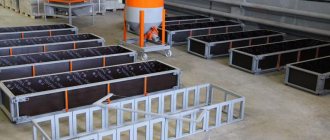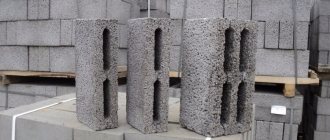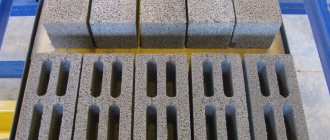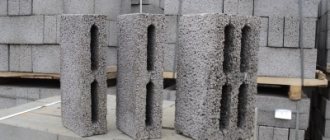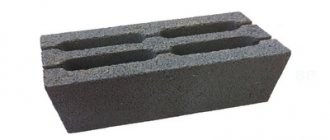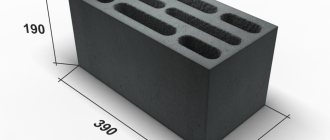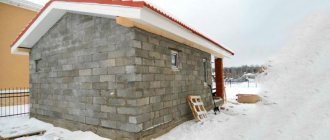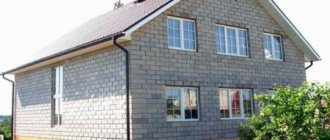Production of expanded clay concrete
At the moment, an increasing number of developers are interested in the process of production of building materials. Many of them pursue the goal of becoming familiar with the basics of production, for subsequent attempts at independent production. And this is no coincidence.
Making products with your own hands contributes not only to the accumulation of invaluable experience, but also to significant savings. In this article we will consider the stages of production of wall material - both in a factory and at home.
Let's figure out the production of expanded clay concrete blocks: what is this process?
Expanded clay blocks: advantages and nuances
Expanded clay blocks are widely used in the construction industry; they are also called expanded clay concrete. Due to the presence of a special filler in concrete - expanded clay, the material is highly durable and lightweight. In addition to the advantages, like any material, expanded clay blocks have their disadvantages.
Different sizes of expanded clay concrete blocks make it possible to expand the scope of application of this building material. Manufacturers produce blocks, the parameters of which depend on the individual order.
The most common ones are:
- 190x390x90 mm;
- 190x390x188 mm.
Compared to brickwork, such a block replaces three to seven bricks. The indicated dimensions are optimal for the construction of residential, civil or industrial premises. Expanded clay concrete blocks have similar technical characteristics, which we will consider below.
First of all, let's say that they hold heat very well.
Types and characteristics
Construction with blocks is much faster than with bricks. The cost directly depends on the size of the blocks and their design.
All expanded clay block sizes have clear boundaries with slight variations, and they cannot be exceeded more than indicated:
- length +/- 0.4 cm;
- height +/- 0.4 cm;
- width +/- 0.3 cm;
- plane of edges and edges of straightness - no more than 0.6 cm.
The dimensions and width of expanded clay blocks are important when determining the area of application of the block. Some are best used in the construction of residential buildings, while others are better used for industrial premises.
Today there are two types of blocks:
- Wall ones - most often 20x20x40 cm. They are used to create load-bearing external walls.
- Partition walls – 10x20x40 cm. Designed to form interior partition walls.
Transporting and storing standard-sized blocks is much easier than custom-made ones. The work process does not require special tools and equipment.
The special properties of expanded clay concrete blocks make it possible to use them for the construction of not only one-story, but also multi-story buildings where there is a heavy load - multi-story garages, shopping centers and others.
The strength of the material is no less important.
The production of such building material occurs in accordance with GOST 6133-99. Technical characteristics of expanded clay concrete blocks:
- compressive strength according to standard M35 – M100;
- thermal conductivity is A-7;
- stone weight from 15 to 26 kg;
- density parameters 950-1900 kg/m2;
- frost resistance F35 – F50;
- presence of radioactivity in accordance with certificate No. 71.ТЦ.04.574.П.000203.03.07.
Depending on their purpose, blocks are divided:
- Solid ones are the most expensive type, because a lot of raw materials are used to form such blocks. They are used to create load-bearing structures.
- Hollow - mainly perform soundproofing and heat-insulating functions. Inexpensive because a small amount of materials is spent on their production.
The composition of expanded clay concrete includes the following components:
- cement;
- sand;
- water;
- expanded clay – granules whose size is more than 0.5 cm.
The durability of expanded clay concrete blocks is another reason to turn your attention in their direction
After mixing, the material dries naturally. Therefore, the blocks are solid and monolithic, which gives even more strength.
Colored coatings
Expanded clay concrete blocks are used in the construction of walls both indoors and outdoors. Therefore, colored coatings will give the room an aesthetic appearance. Using this material, you do not need to additionally plaster the walls, which will significantly save your budget.
Facing blocks have a large selection of color palettes, so it is easy to choose your own color for each client. After finishing the blocks with cladding, there is no need to additionally paint or decorate the walls, because they will already have a decent appearance.
With decorative coating
Expanded clay concrete building blocks with cladding are used to cover the building. The structure consists of:
- concrete, located in two layers;
- polystyrene foam, which is located between the concrete balls.
Cladding with expanded clay will cost several times less than other materials. Using blocks with decorative coating, you can insulate old buildings or cladding them. All this allows them to be used to form a unique design on any external surface. The choice of block colors and variety of textures will easily transform any structure.
Expanded clay concrete blocks are environmentally friendly
It is not necessary to use monotony in your work. It is often practiced to use several colors on one wall.
The concept of expanded clay concrete
It would be important to first familiarize yourself with the material itself. Consider what properties it has, what factors can influence their change - and most importantly, what type or type of product you should pay attention to when planning the construction of a particular structure.
Basic properties and composition of the material
The main filler of expanded clay concrete mixture is expanded clay itself. It can be of different fractions, which directly affects the final result. In addition to it, the composition includes cement, sand, water and various additives that can improve the quality of the mixture and future products.
Composition of expanded clay concrete block
Pumice or slag gravel, sand, algoporite, and crushed stone can also be used as filler.
Expanded clay makes the product lightweight and reduces the thermal conductivity coefficient. Cement, in turn, gives strength.Let's look at what characteristics expanded clay concrete blocks have and analyze how suitable this material is for your building.
- The ability to retain heat of expanded clay concrete blocks is quite competitive, especially if you compare this coefficient with the density of the material. The numerical value ranges from 0.14 to 0.45. This is significantly more than that of cellular concrete, but it is worth noting that the density of the latter is lower.
- The number of frost resistance cycles can reach 200. This is an enviable indicator for almost all wall materials.
- Density varies from 400 to 2000 kg/m3.
Note! Expanded clay concrete belongs to the class of lightweight concrete, and is the only one of all materials that achieves such a density. It is used in the construction of foundations and plinths, which is also an exception to the rule.
- Shrinkage. Expanded clay concrete is not subject to shrinkage at all - and this is a significant plus. As a result, the walls are not susceptible to deformation, and the appearance of cracks in this regard is excluded.
- Hygroscopicity is characteristic of expanded clay concrete, but the figure of 18% is relatively small. Products need protection from moisture.
- The wall thickness for the middle region of Russia should be at least 500 mm, subject to subsequent insulation. It's not that much.
Classification of block products, selection of the optimal type of block for construction
Now let’s talk a little about the classification of products, and let’s try to choose the most suitable option for production.
Note! Not all products presented below can be made at home. The production of some requires expensive equipment, which will make the process of small production unprofitable.
Expanded clay concrete blocks, in accordance with their purpose, can be:
- Wall, used for the construction of walls;
- Partition walls, used in the installation of partitions;
- Ventilation, characterized by the presence of special holes for wiring utilities;
- Fundamental, with maximum strength and density. They are large-format products and can be produced in the form of hollow and solid blocks;
- Blocks of prefabricated monolithic floors.
Expanded clay concrete block with cladding
The latter are used when laying walls and partitions and require subsequent finishing. Products with cladding do not require further finishing. There can be either two or one front sides.
The possible structure of the block determined the presence of hollow and solid products. The first option is lighter in weight and less durable. Has a low thermal conductivity coefficient.
Hollow expanded clay concrete block
Solid blocks are heavier and denser and can withstand significantly greater loads.
Solid expanded clay concrete block, photo
The surface structure of blocks can be different: polished, chipped, smooth, corrugated.
- Corners can be rounded or straight. The blocks may have a groove, a ridge, or have a smooth surface without any grooves or depressions.
- The average density indicator became the basis for the emergence of another classification, which at the same time determines the scope of application of the material.
- In accordance with this, blocks are divided into: structural and thermal insulation, thermal insulation and structural.
- The first type is characterized by a density of 500-900 kg/m3. Popular among private building owners. Used in the construction of partitions and walls. At the same time, houses can reach a height of 2-3 floors.
- Thermal insulation products are not capable of resisting loads. They are used for insulating buildings as a thermal insulation material.
- Structural expanded clay concrete is the most durable and dense. However, in contrast to this, its thermal conductivity coefficient also increases significantly, which necessitates additional insulation.
Such products will differ from each other. The autoclave will be stronger and less fragile. Its geometry, as a rule, is better, and its performance characteristics are higher. At home, it is possible to produce exclusively non-autoclaved products.
Strengths and weaknesses of buildings built from expanded clay concrete blocks
Before moving on to the production process, let's figure out what positive and negative qualities expanded clay concrete blocks have.
Let's start with the advantages of the material:
- The material is environmentally friendly and does not contain harmful or dangerous substances.
- Expanded clay concrete block is lightweight, which reduces the load on the building foundation.
- Large dimensions can increase the speed of construction of a structure.
- Low price.
- Possibility of do-it-yourself production.
- High strength, density and frost resistance.
- Durability of the material.
- Wide scope of application.
- Variability of sizes and choice of manufacturers.
- Vapor permeability and sound insulation.
- Low thermal conductivity coefficient.
- No tendency to shrinkage or deformation.
- Expanded clay concrete is not susceptible to biological influence.
- Fixation of almost any hardware, ease of fastening objects to the wall.
- Good adhesion to finishing materials.
- Variability of interior decoration and façade cladding.
On the left - standard sizes of expanded clay concrete blocks
There are also disadvantages.
The main ones are the following:
- Fragility of products;
- Difficulty in processing;
- Hygroscopicity;
- Prevalence of handicraft industries.
Advantages of the material
Before starting any construction, it is important to consider the pros and cons of expanded clay blocks. They have many advantages and positive qualities that are important in the construction of buildings.
Thermal insulation
The material has good thermal insulation. Houses built from expanded clay concrete blocks are warm. The degree of heat retention by expanded clay concrete blocks directly depends on the amount of expanded clay filling.
Solid blocks will provide the best thermal insulation. In addition, the properties depend on the manufacturer. When making blocks, he can save on expanded clay and replace some with other materials. In this case, even solid blocks will not guarantee good heat retention.
Therefore, if the material is made with high quality, and the manufacturers did not spare expanded clay, then the blocks will have high thermal insulation rates. This explains its popularity in the cold countries of Scandinavia.
The specific gravity of a wall made of expanded clay concrete blocks is approximately 2.5 times less than that of brick
Durability
Since the material has good frost resistance, the constructed building will last for decades.
Strength
If you use expanded clay concrete blocks with strength grade M75, then you are allowed to build a three-story building. This material is an ideal combination of strength and heat retention. Strength is expressed in megapascals - MPa. Depending on this indicator, the use of blocks will differ.
Frost resistance
An important indicator for a building material. The designation F together with the number indicates how many freezing and thawing cycles the material is designed for. Expanded clay concrete blocks can withstand repeated repetition of these cycles, which allows them to maintain their properties for a very long time.
Vapor permeability and moisture resistance
The material has low moisture absorption rates. This affects the general condition of the units and their service life. Water that is absorbed by any material during the cold season freezes and expands. As a result, the material becomes cracked and destroyed.
Expanded clay filling provides not only a good climate in the house, but also excellent sound insulation
Environmental friendliness
Expanded clay concrete blocks are highly environmentally friendly due to the use of natural materials - sand, water, cement and expanded clay. No more chemical components are added. There are also no surfactants - surfactants that are used to create gas blocks.
Ease
A wall made of such blocks weighs two and a half times less than one made of brick. Therefore, the foundation may not be as strong.
Labor intensity and cost
You can create structures from blocks with your own hands using step-by-step instructions. Creating masonry from expanded clay concrete is much faster than from brick. One block can replace about seven bricks. Since the process occurs at a faster speed, less effort and finances are spent. After all, the cost of such a number of bricks is equivalent to one block. You will also need less solution than usual.
Noise insulation
Expanded clay filler helps achieve this. It also creates a good indoor microclimate. Sound insulation is especially important for construction in noisy places (near railways, highways, industrial zones).
Another plus is the chemical inertness of expanded clay blocks, as well as the ability to resist fungus
Chemical inertness of expanded clay concrete
Therefore, fungus, mold and pathogenic microorganisms do not appear on the blocks.
The listed advantages of expanded clay concrete blocks speak for themselves. Of course, there are also disadvantages to this material. But the advantages are enough to start using them.
Calculation of cement mortar
Conventional cement-sand mortar (CSM) is usually used as the main binder for laying expanded clay concrete blocks. It is purchased in the form of a dry mixture or made from sand and cement at the construction site. The finished mixture is a little more expensive, but at the same time the components are already mixed in the required proportion, which eliminates errors and some preliminary steps.
An important factor affecting consumption is the geometry of the block. If the products have significant deviations (more than 1 mm), then the masonry joint must be made thicker. Thickening of the masonry joint leads to a decrease in the strength of the entire masonry. The optimal seam for expanded clay blocks with relatively good geometry should be 5 – 10 mm.
Expanded clay blocks are not suitable for masonry with thin joints. It is also not recommended to lay them on mineral adhesives.
It is believed that the approximate consumption of mortar per 1 cubic meter of masonry is 40 kg with a 10 mm seam, but this parameter can vary greatly depending on the experience of the mason and the quality of the material.
Self-preparation of masonry mixture
The grade of masonry mortar should not exceed the grade of blocks by more than twice. For M50 expanded clay blocks, it is recommended to use a solution no larger than M100. This parameter can be adjusted by the ratio of sand and cement.
Cement M500 in a ratio of 1 to 4 with sand will give a solution of M100, M400 - M75.
- To prepare the mixture, you will need a concrete mixer, since in manual mode the process will take too much time.
- The sand must first be sifted to remove stones and inclusions of large fractions.
- Half a bucket of water is poured into a concrete mixer and a plasticizing compound is added to increase the elasticity of the solution.
To save money, builders often use liquid soap or detergents, but such homemade plasticizers significantly reduce the quality of the mixture.
- Add half the sand and cement to the water, continuing to mix.
- Add the rest of the mixture and add water. Stir until a thick, creamy mass is obtained.
- The solution should be used before it starts to harden.
Disadvantages of the material
In addition to the advantages, expanded clay concrete blocks have their disadvantages:
- The appearance of expanded clay concrete may require further cladding. Although recently this texture has served as a bold basis for interior design.
- When constructing large structures, accurate calculations are required that will take into account the strength of the material.
- Heavy concrete has better physical and mechanical properties than expanded clay concrete due to its high porosity.
- Ventilation of the walls is more difficult than in the brick version.
Despite this, the quality characteristics of expanded clay blocks mean much more than minor disadvantages that can be easily eliminated.
Due to the increased level of porosity, the physical and mechanical characteristics of expanded clay concrete are slightly inferior in comparison with heavy concrete
Recommendations
If you have the desire, time and funds, then it is quite possible to make expanded clay concrete blocks yourself. First you need to make or purchase a machine for making expanded clay concrete blocks. If you have it, creating blocks of the required dimensions will not be difficult for you. Such production is beneficial for those who are planning to build a house or any other structure on their own.
In order for construction to be as efficient and effective as possible, you need to know how much building materials you will need. To do this you need to be able to calculate their number.
In order not to use many formulas, you can use a special calculator for expanded clay concrete blocks, into which you need to enter information:
- length, height and width of expanded clay blocks in mm;
- perimeter of all walls (total length) in m;
- height of walls at corners in cm;
- wall thickness;
- thickness of the mortar in the masonry in mm;
- masonry mesh;
- block weight.
After this, you will receive the number of blocks required for this construction. Using such a service, you will save on materials because you will not buy anything extra.
The decision to build a house from expanded clay concrete blocks will be correct if you plan to build a warm and durable house for many years
When building houses, floors are often made with expanded clay. This is true for private houses or those premises that are located on the ground floor. Expanded clay retains heat well and has a high level of thermal insulation.
The use of this material is well suited for the construction of specific buildings. Do you want to know how to build a sauna with your own hands from expanded clay blocks? It is enough to familiarize yourself with the materials on the topic.
Step-by-step analysis of the production process
Since we have understood the features of the material, it’s time to start considering the production stages. It’s worth starting with a review of the required set of equipment and raw materials.
Equipment and raw materials
If we talk about the production of blocks in a factory, then it is possible to purchase and use several types of equipment:
- Conveyor type. It is distinguished by maximum automation and large volumes of daily production. The cost of such a line is quite high, but payback, as a rule, does not take more than 12 months from the date of launch.
Fragment of a conveyor line for the production of expanded clay blocks
- Landline line. Characterized by a more budget-friendly cost. Human participation is necessary not only as an operator. You can choose the complete set yourself.
Stationary line for the production of expanded clay concrete blocks
Making expanded clay concrete blocks at home requires the presence of a concrete mixer, a vibropress and molds for blocks.
- It is also possible to use a mini-installation. It is capable of producing up to 25 m3 of products per day. This depends on the model and, in turn, on the power, cost and manufacturer.
- You can also build the equipment yourself to save money. It is quite possible to make a machine for making expanded clay concrete blocks with your own hands. To do this, you will need instructions and a certain set of necessary parts.
- Now a little about raw materials. As already mentioned, the expanded clay concrete mixture includes cement, sand, water and filler. The most popular filler is expanded clay.
The structure of the composition determines the type of concrete in the future.
In accordance with this, it is divided into:
- Large porous;
- Coarse-grained;
- Moderately dense;
- Dense;
- Fine-grained;
- With intergranular porosity.
The amount of cement, in relation to the total mass, determines the future density and strength of the composition.
Manufacturing technology
The technology for making expanded clay concrete blocks with your own hands involves preparing the solution yourself. Let's start with this.
When mixing the mixture, it is worth considering that the proportions for the production of expanded clay concrete blocks have not been precisely established; there are only recommendations. Therefore, you need to be prepared for the fact that you may not get a perfectly high-quality block the first time.
Mix the solution in the following order:
- First of all, water is poured into the concrete mixer in an amount of approximately one part in relation to the total composition.
- Expanded clay gets there second, its quantity is about 6 parts.
- Next, sand is poured in three parts.
- The last thing to add is cement - one part.
Approximate proportions of raw materials for the production of expanded clay concrete mixture
Advice! Pay careful attention to the selection of raw materials. The grade of cement should not be lower than 400, the shelf life should not be expired. By using high-quality materials, you partially guarantee a good result.
Making expanded clay concrete blocks with your own hands consists of certain stages.
Their essence boils down to the following:
- The finished mixture is molded and placed on a vibropress. Through vibration, the solution is compacted, which significantly increases the strength characteristics of future products.
- The solution falls into the molds, the excess is carefully removed.
- Subsequently, the products should harden slightly for about a few days.
- The next stage will be stripping.
- The blocks reach technical maturity after 28 days.
If there is an autoclave, the products are processed in it at the last stage. In this case, you will not have to wait 28 days. Brand strength is achieved after 12-14 hours.
Storing blocks at the factory
The advantages of factory-made blocks over self-made products are as follows:
- They are generally more durable;
- Composition and quality are controlled in accordance with GOST;
- The blocks have better geometry;
- Self-production takes a lot of time and delays construction.
- The durability of autoclave products, as well as their performance characteristics, are higher.
The video in this article: “Review of expanded clay concrete blocks” will tell you about the features of this material.
Reviews
Real reviews about expanded clay blocks indicate the high popularity of the material and its high qualities. Also, reviews of expanded clay concrete blocks will help create a complete picture of its use in practice.
- We bought blocks of expanded clay concrete to build a summer house. And we are completely satisfied with it. The cottage turned out to be warm and cozy. Due to the size of the blocks, construction went quite quickly, and we managed to cope on our own.
- I took expanded clay blocks with cladding in order to transform the facade of an old house. The blocks are light and colorful. Thanks to their properties, I was able to not only decorate the wall, but also significantly insulate the house.
